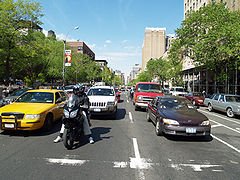vehicles stopped at a red traffic signal on Second Avenue in Manhattan
Traffic waits at a red signal on Second Avenue in Manhattan.
Congestion pricing in New York City is a proposed traffic congestion fee charged to vehicles traveling into or within a predetermined area in the Manhattan central business district of New York City. A congestion pricing scheme was first proposed in 2007 by New York City Mayor Michael Bloomberg but the proposal stalled in the New York State Assembly. In 2017, Governor Andrew Cuomo reintroduced the congestion pricing proposal in response to the New York City Subway's state of emergency, during which the subway was found to have ongoing reliability and crowding problems due to chronic funding deficits. However, Mayor Bill de Blasio opposed the proposal, which was ultimately not included in the state's 2018 budget. A commission, organized in late 2017, that was tasked to investigate the feasibility of congestion pricing found that a congestion pricing scheme could benefit New York City. If approved and implemented, New York City's congestion pricing zone will be the first such fee scheme enacted in the United States.
Since the early 20th century, there have been proposals for a traffic congestion fees or limit for vehicles traveling into or within the central business district of Manhattan in New York City. A recurring proposal includes adding tolls to all crossings of the East River, which separates Manhattan from Long Island; currently, four bridges across the East River do not charge any tolls. In the 1970s, after New York City was deemed to be in violation of the Clean Air Act, Mayor John Lindsay proposed limiting cars in Lower Manhattan and tolling all crossings of the East River, but ultimately withdrew the proposal. Lindsay's successor Abraham Beame subsequently opposed the tolling scheme. Beame's successor Ed Koch attempted to restore limits on vehicles entering Manhattan, but the federal government preempted his plan. New York City was judged to be compliant with the Clean Air Act in 1981, and through the 1980s and 1990s, other proposals to limit congestion in New York City stagnated.
The congestion pricing charge proposed in 2007 by Mayor Michael Bloomberg was part of a plan to improve the city's future environmental sustainability while planning for population growth, entitled PlaNYC 2030: A Greener, Greater New York. However, the proposal did not succeed, as it was never put to a vote in the New York State Assembly. Since then, there have been several similar proposals. In 2015, transportation engineer Sam Schwartz suggested placing tolls on all East River bridges. Two years later, Governor Andrew Cuomo proposed a similar congestion pricing scheme but that will take advantage of recent advances in open road tolling technology.
Contents
1 Early plans
2 Bloomberg's 2008 proposal
2.1 Components
2.2 Reaction
2.3 Vote on proposal
3 2015 proposal
4 2017 proposal
4.1 Components
4.2 Reaction
5 See also
6 References
7 External links

Hi! I am a robot. I just upvoted you! I found similar content that readers might be interested in:
https://en.wikipedia.org/wiki/New_York_congestion_pricing
Downvoting a post can decrease pending rewards and make it less visible. Common reasons:
Submit